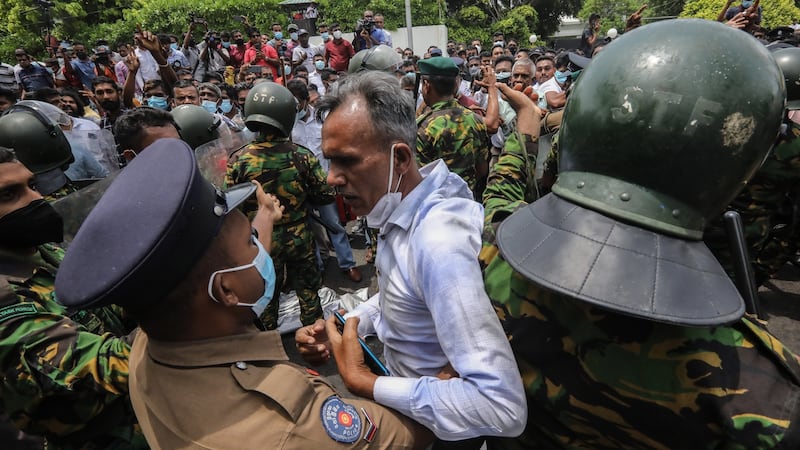Sri Lanka’s prime minister resigned on Monday to make way for a unity government to try to find a way out of the country’s worst economic crisis in history, but protesters said they also wanted his brother to stand down as president.
Prime minister Mahinda Rajapaksa’s resignation came hours after clashes broke out in the commercial capital Colombo, where supporters of the ruling party stormed an anti-government protest camp and were beaten back by police using tear gas and water cannon.
A nationwide curfew has been now been imposed, on top of the state of emergency that Sri Lankan president Gotabaya Rajapaksa – the prime minister's younger brother – declared last week in the face of escalating protests.

The island nation of 22 million people has suffered prolonged power cuts and shortages of essentials, including fuel, cooking gas and medicines, and the government is left with as little as $50 million (€47.5 million) of useable foreign reserves.
Enraged by the worsening situation, Sri Lankans have been taking to the streets in largely peaceful protests and demanding that the Rajapaksas step down.
In his resignation letter, the prime minister said he was quitting to help form an interim, unity government. “Multiple stakeholders have indicated the best solution to the present crisis is the formation of an interim all-party government,” the letter said.
“Therefore, I have tendered my resignation so the next steps can be taken in accordance with the Constitution.”
Nalaka Godahewa, a government spokesman, said all cabinet members had also stepped down. “Now the president will invite other political parties to form a unity government,” he said. “The president will meet with independent and opposition political parties and we expect a new government in the next few days.”
On the streets of Colombo, the mood was jubilant as cars – some flying the national flag and others sounding their horns – drove along a seaside promenade where clashes had broken out earlier.
Outside the prime minister's residence, Osha De Silva was among the hundreds of protesters celebrating his resignation but said she also wanted the president to step down. "The Rajapaksa regime is corrupt," Ms Silva said, clasping a national flag with both hands.
Iron bars
The prime minister’s departure came during a day of chaos and violence, with pro- and anti-government protesters clashing for the first time since the unprecedented wave of demonstrations took hold in late March.
The confrontation began with hundreds of ruling party supporters rallying outside the prime minister’s official residence before marching to an anti-government protest site outside the presidential office.
Police had formed a line ahead of time on the main road leading towards the site but did little to stop pro-government protesters from advancing, according to a Reuters witness.
Pro-government supporters, some armed with iron bars, attacked anti-government demonstrators at the “Gota Go Gama” tent village that sprang up last month and became the focal point of nationwide protests.
Police used tear gas and water cannon to break up the confrontation, the first major clash between pro-and anti-government supporters since the protests began in late March.
At least nine people were taken to Colombo's National Hospital for treatment relating to injuries or tear gas inhalation, a hospital official said, declining to be identified.
“This is a peaceful protest,” said Pasindu Senanayaka, an anti-government protester. “They attacked Gota Go Gama and set fire to our tents.”
Dozens of paramilitary troops with riot shields and helmets were deployed to keep both groups apart after the initial clashes. The army said it had also deployed soldiers in the area.
“Strongly condemn the violent acts taking place by those inciting & participating, irrespective of political allegiances,” President Rajapaksa said in a tweet. “Violence won’t solve the current problems.”
The government has approached the International Monetary Fund for a bailout, and will begin a virtual summit on Monday with IMF officials aimed at securing emergency assistance.
As dusk fell on Colombo, thousands defied a curfew to rally at Gota Go Gama. “Gota(baya) go home,” the crowd chanted. – Reuters













